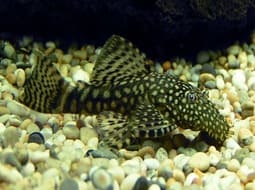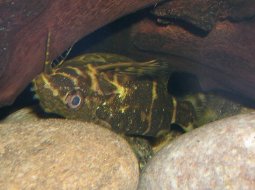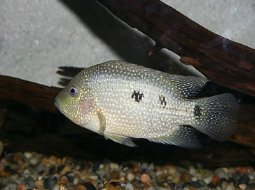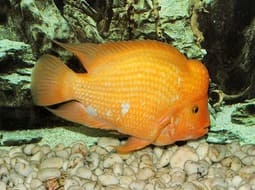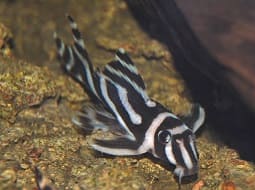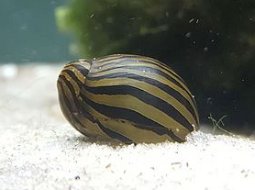
Loading Aqualapp ...
Care and Compatibility of Flowerhorn cichlid - Flowerhorn cichlid
Introduction
The Flowerhorn cichlid is a freshwater hybrid fish that has become extremely popular in the aquarium hobby. This fish is known for its unique and striking appearance, which includes a large, protruding head and a robust and colorful body. Its common name, "Flowerhorn," refers to the flower-shaped protrusions on its head, which vary in shape and size depending on the individual.
Behavior
Flowerhorn cichlids are highly active and territorial fish. They are known for their aggressive behavior, especially during the breeding season. It is important to provide them with adequate space in the aquarium to prevent conflicts with other fish. Although they can be territorial, they can also display interesting behaviors, such as interacting with their owners and recognizing them. Some individuals can be trained to perform tricks and obey simple commands.
Sexual Dimorphism
Sexual dimorphism in Flowerhorn cichlid is subtle. Males are typically larger and have a more pronounced hump on the head than females. Additionally, males tend to have more intense colors and a distinctive spot pattern on the body.
Reproduction
Breeding Flowerhorn cichlids can be challenging as they are hybrid fish and may have difficulties reproducing naturally. In some cases, artificial breeding techniques are used to breed them. Males are usually larger and exhibit more vibrant colors, while females are generally smaller. During the breeding process, males may build nests and care for the eggs and fry.
Aquarium Conditions
The Flowerhorn cichlid is known for its colorful and robust personality. It requires a spacious aquarium with decor including rocks, driftwood, and caves for hiding. Providing a sturdy substrate and maintaining good water quality is important.
Feeding
The feeding of Flowerhorn cichlids is varied and based on a balanced diet. They can be provided with high-quality commercial foods in the form of pellets or granules specifically formulated for cichlids.
Complexity
Caring for Flowerhorn cichlid can be challenging due to its territorial and aggressive nature. They are robust fish, but can be prone to health problems if not provided with the proper environment. They require a varied diet and regular aquarium maintenance.
In case you need more help, or if you want to know into any topic related to the Flowerhorn cichlid (Flowerhorn cichlid) and even any other species you can use the forums to ask what you need.
To do an analysis more detailed about coexistence and behavior of Flowerhorn cichlid (Flowerhorn cichlid) use the Aquarium simulation tool, if you do this you can test different ways to combine the Flowerhorn cichlid with other fishes giving the dimensions and space on you aquarium, on this way you can known the optimal configuration for keep the fishes that you want.
You can also find out the 30 species compatible with the Flowerhorn cichlid (Flowerhorn cichlid) can live together.
Note: The parameters of the water such as PH and temperature are also used to calculate the compatibility of the species.
Compatible species (30)
Compatible (4 Species)
Compatible without any restriction
Knowing Yourself From Small (4 Species)
They can live together if they have known each other since they were very small, that is, they grew up and grew up together. it does not work in all cases, there may be exceptions.
Similar Sizes (1 Species)
They can coexist if they are the same size or very similar sizes, it does not work in all cases, there may be exceptions.
With Reservation (17 Species)
Compatible in some cases, it depends on the nature and personality of the fish.
Las especies territoriales por lo general pueden convivir con especies protegidas con coraza, ya que no pueden hacerles daño por su dura piel, lo que si hay que tener en cuenta es tener un acuario con dimensiones favorables para que cada pez pueda delimitar un territorio, ya que la mayoría de peces acorazados son también peces de fondo y les gusta estar buscando lugares donde ocultarse.
Por naturaleza estos peces saben que no deben comerse a otros peces con exoesqueleto pero podría darse el caso que intente comerlo por hambre o por personalizad del pez.
Showdown over territory (2 Species)
Fish can live together as long as the space is spacious enough to delimit a territory, otherwise there may be aggressions for competing for the territory.
Considerable size difference (2 Species)
They can coexist while they are similar in size or the size difference is not very abysmal, since as the fish grows it increases the chances of eating its partner that did not grow much.
Flowerhorn cichlid
Flowerhorn cichlid
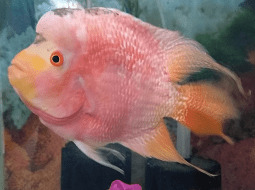
- Ph: 7 - 7.8
- Temperature (c°): 24 - 27
- Measures: 30 cm
- Aquarium Capacity:
210 Liters - 55 Gallons - Alimentación: Omnivores
- Colores: Blue, Orange, Red, Yellow
- Comportamiento: Active, Aggressive, Territorial, Territorial with its species
- Morfología: Bright colors
- Preferencias del Acuario: Caves
- Tamaño: Big
- Taxonomía: Cichlids, Fish
- Tipo de Agua: Sweet water, Tropical waters
- Velocidad de nado o movimiento: Normal
- Zona de Nado: Swim in the middle of the aquarium

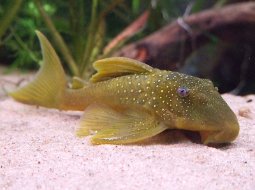

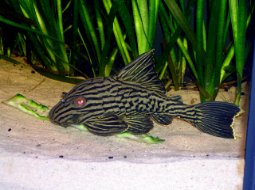


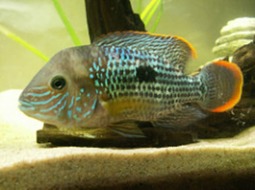
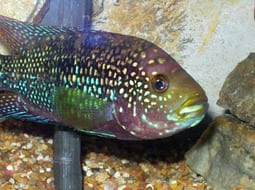
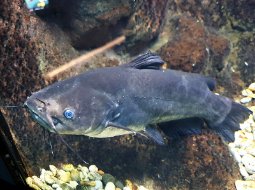

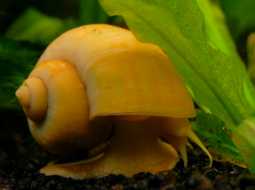



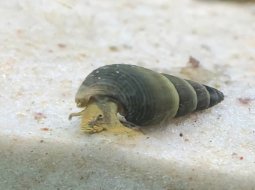
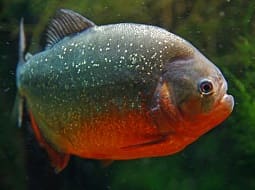

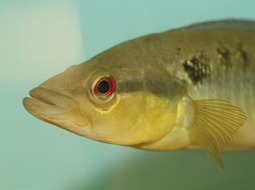
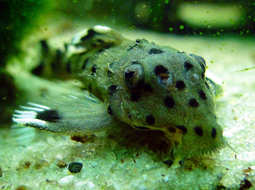
.jpg)

